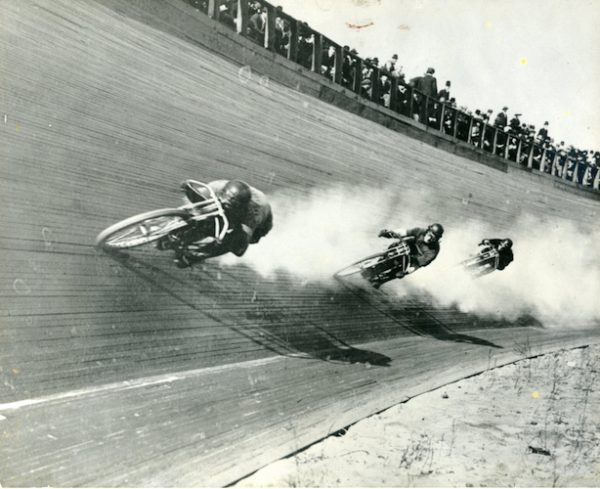Bill’s Bikes
By Bandit | | General Posts
Here’s some of the bikes I’ve had since the late ‘70s. There were several more, but they were just something to roll over and make a few bucks. I am currently buying a ‘98 1200 Sportster slightly wrecked for $1000. I’ll send pictures of what I am doing to it to make money to build my rigid project. When I move it, I’m buying a ‘34 Ford hot rod. If my health holds up.
Wow Deadwood. My old friend Dave Ruth lived there. I was there hanging with him at s
Sturgis 2010. He passed away in 2012, but his son is still there working at the casino. His name is Dave also. They have a ‘76 electraglide with a 96-inch S&S motor.
It’s great in the summer if you can stay in SoCal in the winter. Some 20 below ain’t fun. Been riding my new/old Dyna. It’s almost perfect, but I lost the right hand lid off the old style saddlebags yesterday. It got ran over and crushed. They are from VTwin.
Guess I’m going to break down and buy a good set from BB reproductions. Check out our shop on Facebook it is linked to mine, Independent Cycle in Nashville. He has some of my old bikes down there.
I put bagger air shocks on the Dyna. Because of the different leverage they ride like a caddy with about 80psi in them and lowered it about 2 inches. Lots of those available because people are always putting something else in their baggers.
Check out some of my old iron:
Aunt Betty’s ’70 Electra-Glide
‘76 and ‘79. I owned the ‘76 earlier then sold it to my friend Ross Collins. And traded a ‘47 Indian for the ‘79. I regretted that almost immediately.
I stretched and lowered this for Donna. We didn’t keep it long. Money was always the problem.
Donna on the ‘76 Electra-Glide in ‘82
Only picture I could find of the Indian. Summer of ‘83 I think. The gal is Donna my ex-wife, before I married her. The little girl is her daughter I had lots of problems with. Donna passed away in April 2019. It was pretty hard even though we had been divorced for 17 years.
Bought this new in ‘85 in Reno. Wrecked it on the toy run in December ‘85.
Same FXR after the wreck. They said I couldn’t put a wide glide on it
I bought this from a junkyard in Parumph, Nevada around 1994. Gave $300 for it. Got it running and sold it for $1100 with a bill of sale.
Just before I sold it in 1995 for the second time. It is still running in Austin Texas.
‘51 Panhead. Sumer 2001
–Bill May
1950s Throwback – The Heated Motorcycle Helmet
By Wayfarer | | General Posts
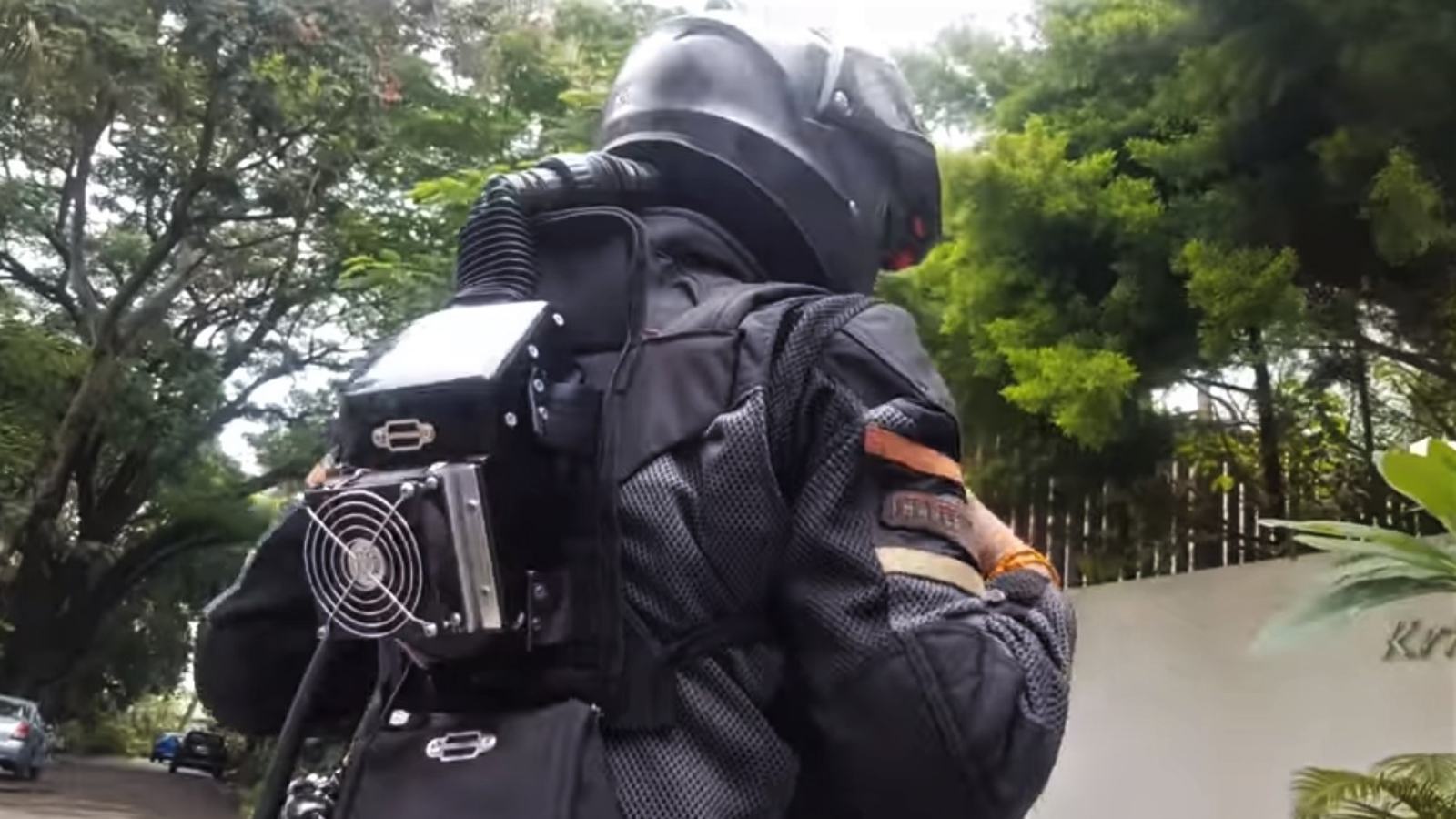
by Florin Tibu from https://www.autoevolution.com
Effervescent and lively as the ‘50s have been, that decade was also littered with some of the funniest contraptions aimed at solving some of the most common issues motorists had. And here’s one of the truly crazy ones, the heated motorcycle helmet.
The video comes from a French outlet and this helmet is presented as the “Thermoscaphe”, so we could assume it is a French invention. Its name is a derivation from the term “bathyscaphe”, a manned submersible vehicle for deep-sea exploration that’s still in use nowadays.
Now, we’re not at all sure that the inventor of the thermoscaphe was serious about it, albeit we reckon that most of the wacky innovators back in the day were convinced that their creations were genius. However, the design of this helmet’s hull is indeed useful, as its all-transparent, 360-degree viewing angle acryllic structure provides excellent sight. And we’re not going into the aerodynamics debate, right?
Obviously not designed for high speed, this helmet doesn’t come with a chin strap, even though it has safety thethers. Presumably it didn’t need a Pinlock lens, as the breathing space between its lower edge and the wearer’s body would ventilate the interior well enough to prevent fogging. And of course, you’ve got additional vents all around…
As for the thermal side of this prototype, we had a really good laugh. The heating element is a primitive one, using an alcohol lamp whose flame heats an air duct. The outside air is pushed through this duct by means of a battery-powered fan, and is supposed to become warmer as it flows through the metal tube. It would be interesting to measure the heat difference, though.
The whole heating device is attached to the left side of the helmet, adding even more weird points to this project. We can only hope that at least the lamp was designed in such a way that alcohol would not easily spill when the helmet is tipped, even though it appears to sit freely, without any visible straps to keep in in place. As if a bike crash and zero shock protection wasn’t enough, having your clothes doused in alcohol and catching on fire seems to be a scenario the creator of this helmet didn’t consider at all.
Helmet air conditioning is still a thing today
Still, the idea of having AC inside a motorcycle helmet was not abandoned altogether. From DYI attempts to actual helmets that are on sale today, many riders thought that being able to avoid extreme temperatures inside their lids was a neat thing. Today, we can find AC add-ons that strap to a helmet and provide a flow of cool air when riding in the summer, such as the BlueSnap from BlueArmor. It is indeed bulky and looks rather unnatural, and most likely is very unnerving when riding at high speed, but you can actually get one.
Or you can go even further and pull the trigger on a makeshift AC unit that you can carry as a backpack. It will cool down air sucked from the outside and push it through a tube inside your helmet. Will it do the trick? Probably yes, but this is hardly a solution, at least from a practical standpoint. Going cyborg certainly doesn’t cut it, especially if you’re using the bike for running errands around the city. Just take a look at what using this type of helmet AC is like and you’ll understand.
Honestly, the best solution we found was the Feher ACH-1 helmet. Dubbed the “Mr. Cool” helmet, this lid comes with an air conditioner perfectly integrated in the back of the helmet, looking pretty cool (pun intended) and unobtrusive. This DOT and ECE-approved lid is also on the lightweight side, as it tips the scales at 1,450 grams or 3.2 pounds, which is still lighter than most casual modular helmets out there.
No idea about craftsmanship and wearing comfort, but if keeping a cool head when riding the bike is crucial for you, the Feher ACH-1 sounds like a good buy at $450, also available in sizes XS through 2XL and in no less than five color options.
We here still use water poured on the liner when riding in very hot weather, sometimes considering a custom scarf made of hi-flow material, worn around the neck, and in whose pouch we can add several ice cubes. Melting ice also wets the undergarments and this helps cool the body, too, albeit being a solution a tad too messy for some.
As for the 1957 heated helmet, is DOES bring to mind the Red Bull Flugtag, an event we just can’t have enough of. Please do have your say on the Thermoscaphe, and who knows how much sillier and funnier ideas might pop up.
Jarvish’s Smart Helmet Can Provide a Better Experience for Motorcycle Riders and Set New Trends in the Motorcycle Industry
By Wayfarer | | General Posts
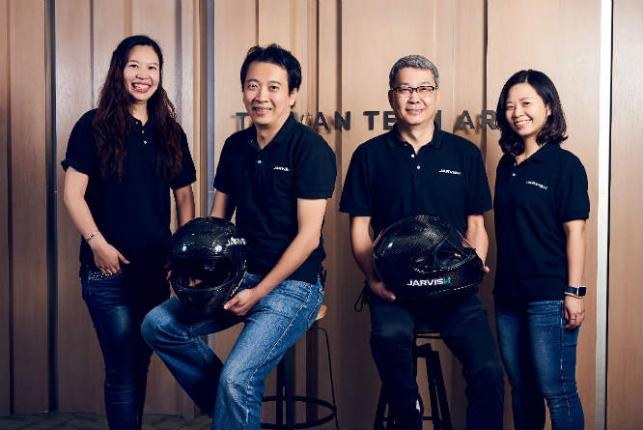
LAS VEGAS, Jan. 8, 2020 /PRNewswire/ — Jarvish and other notable homegrown startups led by Taiwan Tech Arena (TTA) are now showcasing their innovative solutions at CES 2020.
Smartphones have been around for more than 10 years. People nowadays tend to find smart mobile devices that suit their needs and are easy to use based on different usage scenarios. Recognizing this trend – as well as the development of 5G technology which will perfect connected vehicles – startup company Jarvish, whose core members mainly consist of former employees from Hon Hai, has spared no efforts to develop top-notch motorcycle gear for connected vehicles. By utilizing its strong technology integration capabilities, Jarvish has brought the world a smart helmet featuring a stylish design and practical functions.
Jarvish’s smart helmet comes with a built-in 2K HD action camera, a sensor that detects whether the helmet is being worn, OGS surrounding HD sound system, smart voice control system, wireless charging module, and HUD (Head-Up Display) that allows you to browse information while riding. “Unlike other mobile devices, smart helmets need to provide not only high performance and advanced technology but also security. Therefore, we have studied security regulations in different countries and set our eyes on markets with high-security requirements,” said Jeremy Lu, founder of Jarvish. To meet the security requirements, the materials, the placement of the microphone, camera, HUD, battery, and Bluetooth module, as well as the wiring of the helmet must be thoroughly planned. For example, since the battery is placed near the rider’s head, the lithium battery commonly used in commercial products must be replaced with the explosion-proof ceramic battery intended for military use. The ceramic battery can run for up to five hours. Also, the HUD consumes power constantly; therefore, the battery size and the thickness and weight of the EPS insulation panel must be designed properly. These details all demonstrate Jarvish’s ability to integrate technologies from different industries.
When the helmet is connected to the network via a smartphone, the rider can use leading brands’ voice assistants such as Siri, Google Assistant, or Alexa to make phone calls, activate navigation services, listen to music, or broadcast a live video on Facebook without using their hands. The rider can also customize voice commands via Alexa Skills Kit if needed.
Jeremy Lu added that they would try to provide support for all mainstream voice assistants in the helmet. That being said, there are less than 30 voice commands used when riding a motorcycle. Therefore, Jarvish has developed its own voice assistant specially designed for riding scenarios. The company has also worked with the world’s largest mapping software company. By using its own app, Jarvish’ smart helmet can be updated with all kinds of voice information including riding speed, speed camera warnings, weather forecasts, nearby gas stations, nearby Gogoro charging stations, and navigation data.
To protect the rider’s safety, Jarvish’ helmet is not only IPX6 water-resistant but also compliant with CNS, DOT, and ECE standards. When the sensor attached to the helmet detects a crash while it is being worn, Jarvish’s voice assistant will ask the rider if he/she needs an ambulance. The rider can also cancel emergency aid via voice commands.
“Once Jarvish’s smart helmets are widely adopted, the big data they collect can also be used to improve traffic conditions and construct smart cities,” said Jeremy Lu confidently.
AI-Driven Electric Motorcycle Shows Self-Driving Tech Is About More Than Autonomous Driving
By Wayfarer | | General Posts

by John Koetsier from https://www.forbes.com/
Damon Motorcycles unveiled its new electric motorcycle today at CES in Las Vegas, calling it “the world’s smartest, safest and most powerful electric motorcycle.”
My first thought: it can’t be both the most powerful and the safest.
Then I kept reading.
And I started believing it might be possible.
First off: the power. The Damon Hypersport has “over 200” horsepower, which is a lot for a motorcycle. But even more impressively, it delivers 200nm of torque at zero RPMs … the classic electric vehicle advantage. (Although how RPM means something in an electric motor is a mystery to me.) Thanks to that power, the bike has a top speed of 200 miles/hour.
Which, by the way, doesn’t sound very safe.
But the safety features are impressive.
As you’d expect in a motorcycle, they’re not about crumple zones or air bags.
Instead, they’re about intelligence. Specifically, predictive intelligence: what’s around me, where is it going and what do I need to avoid? The Hypersport will track the speed, direction and acceleration of up to 64 moving objects around the bike, Damon says.
Damon calls it the “CoPilot 360º advanced warning system.” CoPilot 360 uses cameras, radar and “other sensors” to know what’s around and alert riders to threats, the company says.
“We spent the last three years developing an AI-powered, fully connected, e-motorcycle platform that incorporates CoPilot, our proprietary 360º warning system … Damon motorcycles will be the safest, most advanced electric motorcycles on the market.”
– Jay Giraud, co-founder and CEO, Damon Motorcycles
That’s not just about what’s ahead of you. The system “looks around corners,” although I’m sure it’s not bending any laws of physics, and keeps an “eye” on the rear to see what might be coming from behind.
And, it will learn your driving habits and adjust accordingly, using onboard artificial intelligence.
“We prioritized data-driven thinking at the epicenter of the company, employing radical innovations in sensor fusion, robotics and AI,” Dom Kwong, the co-founder and CTO of Damon Motorcycles, said in a statement. “This level of deep learning and connectivity are unprecedented, ensuring each rider a smarter, safer and connected ride; not only for individuals but for entire communities, with the goal to reduce incidents worldwide.”
To connect riders and power the bike’s AI and other advanced features, it includes 4G, Wi-Fi and Bluetooth.
Of course, there are two big questions:
One: will riders actually be safer with warnings about oncoming objects, or will they prioritize what they see on the screen versus watching the road? Will a flood of alerts distract them or make them safer?
And secondly: with software, the devil’s in the details. Few transportation companies that aren’t named Tesla do it well. Will this startup be able to ship these advanced technologies in a usable, friendly and safe way?
Damon says yes, citing the foundation of their software:
“By building it on BlackBerry’s best-in-class technology that is safety certified, Damon motorcycles will be the safest, most advanced electric motorcycles on the market,” says CEO Giraud.
That’s BlackBerry QNX, which is built by the former mobile giant, now re-focused on software solutions.
Ultimately, we’ll know when the bike ships.
The Hypersport is available for pre-order now on the Damon website. Pricing begins at $24,995 before any applicable EV tax credits.
And the range? 200 miles on the highway, 300 miles in the city, according to the company.
Damon’s Electric Motorcycle Will Have 200-Mile Range, 200mph Speed, Safety Suite
By Wayfarer | | General Posts

by Bill Roberson from https://www.forbes.com
2019 was a big year for the nascent electric motorcycle niche, and it looks like 2020 is going to start with another shock to the system with Vancouver B.C.-based Damon Motorcycles announcing some eye-opening performance numbers and cutting-edge safety tech for their upcoming machine, called the Hypersport. A prototype Hypersport and specifications were revealed Tuesday morning at the 2020 CES electronics expo in Las Vegas.
Damon claims the Hypersport will be be capable of some fairly hyper numbers, including 200 horsepower, a 200 mile-an-hour top speed, and 200 miles of highway range, as well as 300 miles of range in urban riding. Additionally, the Hypersport will be bristling with technology heretofore unseen on most any motorcycle, including on-the-fly adjustable ergonomics and a car-like rider safety system.
Damon had previously sent out emails ahead of the CES reveal teasing the fact that “200” was their “magic number,” so while it might have been easy to deduce those figures, they still stand out against the specs of competing bikes, which often struggle to achieve half of those performance figures.
A run of 25 premium high-spec bikes with a price of $40,000 will be the focus of an initial Indiegogo crowdfunding campaign, while a more mass-market Hypersport will come in at $24,995. The crowdfunding campaign will complement additional financial backing from Round 13 Capital, Techstars, Fontinalis, Extreme Venture Partners and Pallasite Ventures.
Ahead of CES, Damon CEO Jay Jiraud told Forbes.com the Hypersport will feature their exclusive on-the-fly adjustable ergonomics package, called Shift, and an extensive rider awareness/safety system they call CoPilot. The Shift ergo system will be able to change things like seat height, handlebar height and footpeg location, changing the riding position from a tucked-in sport posture to a more standard-style sit-up arrangement for more comfortable city riding. The bike itself has the form of a sleek sports machine. And while a specific torque figure was not released, Jiraud told Forbes.com the Hypersport will make a “s**tload of torque.” Some of the features can be seen in this video from Damon:
Forbes.com was the first publication to take Damon’s two test bikes for rides this past summer, including the shape-shifting Hypersport prototype and another test machine outfitted with an array of cameras, sensors and electronics designed to give riders a digital heads up on what’s happening around them via a sensor package not unlike what many cars now feature.
Jiraud explained that his vision is to give Hypersport riders more comfort, range and utility from the bike, while also introducing pre-collision safety features that, as of now, have been largely missing from motorcycles while they have gotten ever more sophisticated in cars.
However, the CoPilot system will differ from the automotive systems in that it won’t have the ability to take over operation of the motorcycle; it only gives warning cues about possible dangers around the rider. The reason for the non-intervention is that a motorcycle is an inherently unstable platform, unlike a car, and unexpectedly taking control of the bike away from the rider in any way could result in a crash. Instead, the CoPilot system uses video screens, a rear-facing camera, multiple radar units and position sensors, small LED lights and handlebar vibrations to let the rider know what is happening around the motorcycle. Again, CoPilot does not activate the brakes or affect steering, although Jiraud did not rule out those features in some iteration much farther down the line as A.I. systems, vehicle interconnectivity and other technologies improve.
During a test ride of the system several months ago, I found the tech to be innovative and effective. While it does add some input to the rider while in operation, I found that even after a few miles, it became second nature to see, feel and understand the warning system’s cues.
Likewise, riding the sleek electric bike with the adjustable ergos was also interesting. While some modern bikes allow owners to tailor things like seat height, handlebar rise and footpeg placement, those adjustments typically have to be made with tools while the bike is stopped, and once made, riders are essentially stuck with them until they can be changed again with tools.
Damon’s Shift system works more like your car’s interior. Using a bar-mounted controller, the seat can rise and fall, the bars can move up and down and the footpegs will lift or lower. While the test bike had only two positions for the ergos, Jiraud said future versions would be more adjustable for a true custom fit. Best of all, the Shift system is adjustable while riding.
BlackBerry On Board
Damon CEO Jay Giraud has made some key moves to bring his vision of an electric bike with all the elements of the two test bikes rolled into one battery-powered package. A key development in the quest to get the data-hungry CoPilot system up to par performance-wise was a partnership with BlackBerry and implementation of the BlackBerry QNX suite to power and talk to the numerous sensors, radars and other tech involved in CoPilot. There will also be 4G cellular connectivity.
Once famous for their cellphones, BlackBerry has largely transitioned to a company that makes control systems that work behind the curtain in numerous data systems, with a focus on cars and medical equipment. The QNX system has been installed in over 150 million vehicles and is used by almost all top automakers worldwide, so it’s quite a coup for Damon to have them dip into the electric motorcycle world at this early stage.
Alta Influence
Clearly, this is not Jay Jiraud’s first tech rodeo. While the Damon team was spooling up the Hypersport, Jiraud also added a key player in Derek Dorresteyn, from now-defunct but long-time electric motorcycle maker Alta Motors. Dorresteyn signed on as COO at Damon, which will need his expertise to tease out the promised performance figures for the Hypersport models. Even though both are legacy technologies, batteries and electric motors are two parts of a rapidly developing tech frontier that is seeing huge investments by both corporate and even state-sponsored players.
Jiraud told Forbes.com that Dorresteyn was in the midst of working on a “completely new” electric superbike powertrain system at Alta when the company closed up shop, and he brings a wealth of expertise to Damon. Among the bike’s tech features Jiraud talked about with Forbes ahead of CES was a 700-plus volt, liquid-cooled 20kWh battery pack for the Hypersport, which would be quite large for a motorcycle, but Jiraud says the Hypersports’ architecture can handle the battery pack and that the battery will not be the typical rectangular lump found in many current electric bikes. For comparison, the largest battery available on the class-leading Zero SR-F is just over 16kWh (the standard battery is 14.4kWh), with the bike tipping the scales at a tick over 500 pounds. Meanwhile, the Harley-Davidson LiveWire uses a 15.5kWh pack. Jiraud says he is planning on keeping the weight of the Hypersport under 500 pounds through design and weight-saving measures.
A Challenging Future
The transition of the motorcycle industry from gas to electric has lagged (with some exceptions) behind that of cars due to the challenges of design as well as the space and weight-sensitive platform a motorcycle presents, but battery and motor advances in the bike industry can also represent opportunities to the EV industry as a whole. With the addition of Dorresteyn from Alta, Blackberry’s QNX handling the tech and a clutch of investors, Damon may be in position to lead in terms of range, safety and power once the Hypersport arrives. But things can change fast in the EV world, so stay tuned.
The Damon Hypersport prototype bike can be seen at BlackBerry’s booth at CES 2020. Deliveries are slated for 2021.
Why A Car Tire On A Motorcycle Is A Bad Idea
By Wayfarer | | General Posts
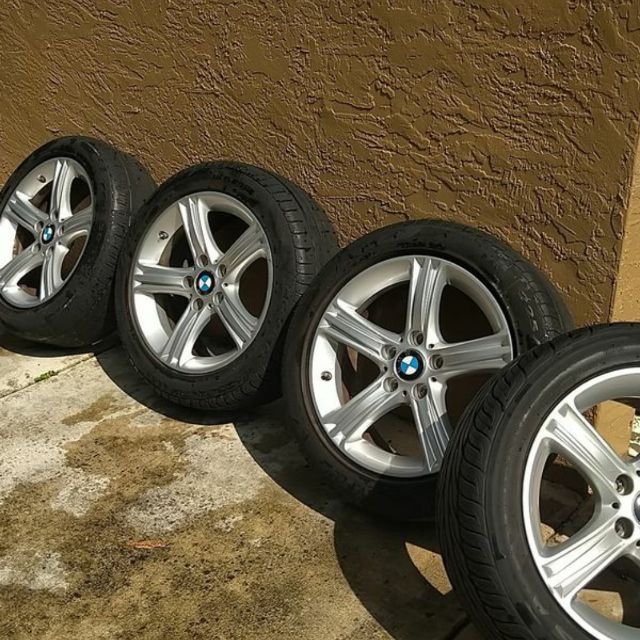
by Justin Hughes from https://www.rideapart.com/
They call it the “dark side” for a reason.
A while back, Kate discussed the perils and pitfalls of using a car tire on the back of your motorcycle, a practice known as “the dark side.” A video just came across a Facebook group I’m on demonstrating, clear as day (the daylight you actually see under the tread), why this isn’t good.
Where The Rubber Meets The Road:
What it comes down to is simple. Bikes lean. Cars don’t. OK, yes, cars do lean a little due to weight transfer and suspension loading and unloading. I autocrossed for years—I get it. In the car world, though, we fight against this lean as much as we can with stiffer springs and sway bars. We’ll even dial some negative camber into the alignment so that when the car goes around a corner at full tilt, the tire is straight up and down for maximum grip. A car tire has its maximum grip when its full tread width is in contact with the road.
Motorcycles, on the other hand, need to lean in order to turn at any speed faster than walking. It’s the fundamental way that bikes work. Motorcycle tires are made to lean. Their profile is round, not square like a car tire. In most cases, you’re either going to drag hard parts while leaning hard or chicken out before you lean hard enough to get onto the tire’s sidewall.
Here, though, we have a perfect view of a car tire on the back of a Honda Valkyrie. On the surface this may seem like a good idea for such a big, heavy bike, especially if it does a lot of highway travel where it doesn’t lean much. Here, though, it’s on the Tail of the Dragon, a stretch of US 129 on the border of North Carolina and Tennessee with 318 curves in just 11 miles. It’s a twisty paradise for motorcyclists and sports car drivers, but the worst-case scenario for a car tire on a motorcycle.
I encourage you to watch the video, but even the thumbnail says it all. When the bike is leaned over, that car tire is on its edge, with only about one-third of the tread contacting the road. This is the exact situation that autocrossers strive to avoid. Even worse, the harder you turn, the more you lean, and the less tread contacts the road precisely when you need grip the most. In particularly hard turns, the car tire rolls up onto the sidewall, which is never intended to contact the road. I’ve had road debris puncture tires on my cars without much difficulty. You don’t want to vastly increase the chance of this happening by placing the sidewalls directly on the road.
If the only riding you do is long stretches of highway with no turning at all, I suppose a car tire could work. They do last much longer than motorcycle tires, though if you’re leaning hard through the turns the edges of the tread will wear extremely quickly. Ask this former autocrosser how I know. Personally, I find the turns to be the most fun and challenging part of riding. If I’m going to attack the twisties, I want a back tire that’s designed for the job, and that won’t give up its grip right when I need it most.
AMA Alert–RPM Act reintroduced in U.S. House of Representatives
By Bandit | | General Posts
Tell Congress to support your right to race!
The Recognizing the Protection of Motorsports Act (RPM Act, H.R. 5434) was reintroduced in the House by U.S. Rep. Patrick McHenry (R-N.C.) and cosponsored by Rep. Raul Ruiz (D-Calif.), along with five other original sponsors: Reps. Richard Hudson (R-N.C.), Kurt Schrader (D-Ore.), Bill Posey (R-Fla.), Gil Cisneros (D-Calif.), and Michael Burgess (R-Texas).
The bi-partisan RPM Act would ensure that converting motor vehicles into competition-only vehicles remains legal. Street motorcycles are considered motor vehicles under the federal Clean Air Act.
The RPM Act states that it was the clear intent of Congress when passing and amending the Clean Air Act that motor vehicles, including motorcycles, used solely for competition would be exempt from the Clean Air Act’s prohibitions against modifying emission control devices.
The American Motorcyclist Association supports the bill and its protections for amateur and professional racing enthusiasts.
Tell your represenative you support H.R. 5434. Send a prewritten email by using the convenient AMA Action Center.
|
Local Businesses Host Motorcycle Ride
By Bandit | | General Posts
JACKSON, Tenn. — A local business hosted a fun motorcycle ride.
Motorcyclists gathered for the first Frost Butts Ride hosted by Bumpus Harley-Davidson of Jackson.
General manager Mike Gay says the ride is a way for bikers to come together, go on a ride in the cold weather, have some lunch at a local restaurant and fellowship with one another.
“This ride, and it’s kind of a secret ride,” Gay said. “We don’t tell anyone until the day, we get out here and start gathering around and do a safety briefing, but this ride will be going to Mercer to a restaurant called Papa Daddy’s.”
Gay says he hopes to make this an annual event.
–WBBJ Local News ABC affiliate
Rally in the Alley–Vegas Style
By Bandit | | General Posts
Hogs and Heifers Saloon in Las Vegas is known for their drinks, but more notably for their scantily clad bartenders dancing on bars between pours. Normally, they do this inside the saloon, but when they move it outdoors, you know you’re in for one heck of a party. In fact, the event was expected to be so large this year, that they had to move it down the street to the bus depot behind the Mob Museum. This gave them room to add more vendors (30+) and build a massive outdoor bar for the ladies to do their dancing.
https://quickthrottle.com/rally-in-the-alley/
Monster Energy® Kawasaki’s Adam Cianciarulo Podiums in Monster Energy Supercross 450SX Debut
By Wayfarer | | General Posts

Foothill Ranch, Calif. (January 5, 2020) – Monster Energy® Kawasaki came into the 2020 Monster Energy AMA Supercross, an FIM World Championship season opener in Anaheim, California feeling stronger than ever with the dynamic rider duo of Eli Tomac and Adam Cianciarulo. Cianciarulo making his Monster Energy Supercross 450SX debut picked up right where he left off at the Monster Energy Cup, showing great speed aboard his KX™450 all day long. The rookie was able to capture the fastest qualifying, a second place finish and a spot on the podium.
While a true rookie in the 450SX class, Cianciarulo made the rest of the competition aware that he was a true player in this title chase. Cianciarulo started the day off perfect by setting the fastest times in all three practice sessions and finished second in his heat race. In the Main Event, Cianciarulo made quick moves to put his KX450 into second place and began to hunt down the leader. After a mistake from the leader, Cianciarulo was able to capitalize and begin building a lead over the field, however, a minor mistake cost Cianciarulo the win in his debut race, he continued to push, finishing in second place.
It is no secret that the No. 3 machine of Eli Tomac is a title contender and podium contender every time he lines up to race his KX450. Tomac showed this early in the day, qualifying in second place position heading into the night show. However, in both the heat race and main event a mid-pack start would ultimately hamper his results. Tomac finished the evening in seventh place overall.
After months of build-up to the Monster Energy Supercross opener at Angel Stadium, neither the racing nor the fans were disappointed. 45,050 fans packed the stadium to watch the greatest racers in the world compete on the biggest stage in supercross.
“I fell in love with Supercross watching Anaheim 1back in 1999. Ever since then I’ve been dreaming about what I got to experience tonight. Everything from opening ceremonies to getting my first 450 podium. I was bummed we couldn’t capture the win, but regardless I am stoked on this result. It is a long season, I still have a lot to learn and build on from here, but I am already fired up to go racing next weekend in St. Louis.”
– Adam Cianciarulo
“Man, the first race of the season is always an interesting one. The whole day is just chaotic. I started feeling a bit of a flow by the end of the last qualifying session today, but in both the heat race and main event tonight I got decent starts but got shuffled back in the first turn and the way the track broke down tonight it became very one-lined and difficult to make passes. The competition this year is deeper than ever, so we will regroup this week and come out swinging in St. Louis next weekend.”
– Eli Tomac
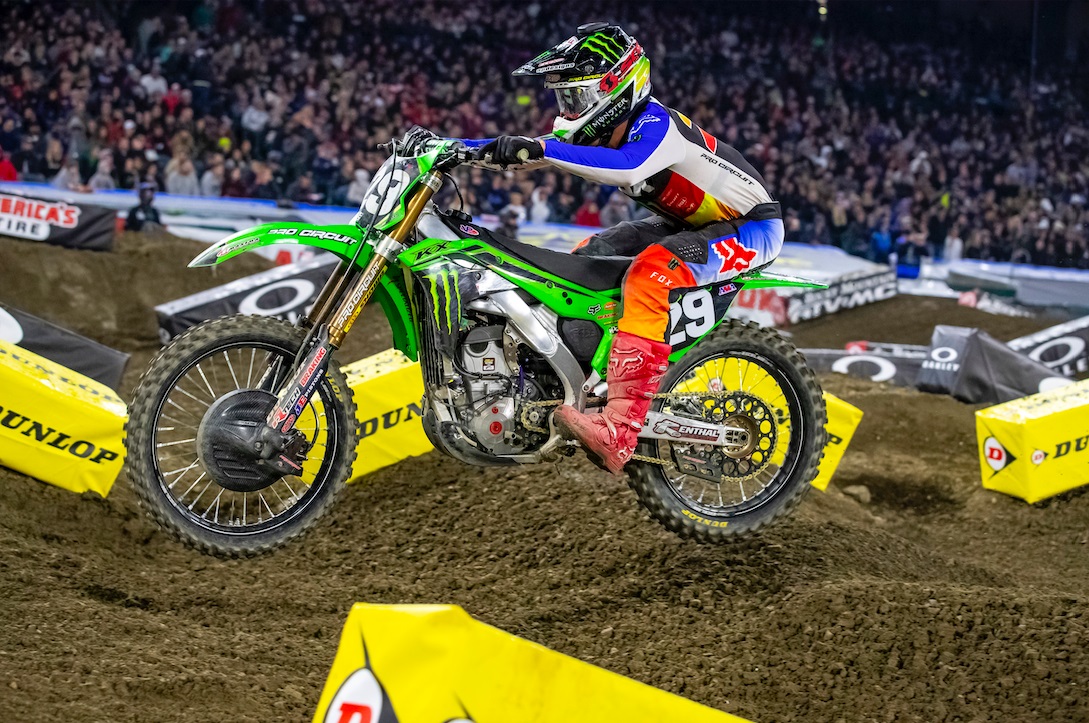
The Monster Energy/Pro Circuit/Kawasaki team of Austin Forkner and Cameron McAdoo came out charging at the season opener of the 2020 supercross series. Both having something to prove, Forkner was prepared to return to racing and his winning ways after his season was cut short by an injury last year, while McAdoo was ready for his Kawasaki debut aboard his KX™250 motorcycle.
After qualifying sixth on the day, Forkner charged through the field in the first heat race of the night moving into second position. Following an aggressive pass from one of his contenders, Forkner fell back to fourth but quickly made up time and made his own pass into third where he would finish.
The No. 29 of McAdoo kicked off the day qualifying with the fifth fastest lap time before entering his heat race. In 250SX Heat 2, McAdoo quickly made his way into third, where he went on to cross the finish line.
As the gate dropped on the 250SX Main Event, it was Forkner who grabbed the first holeshot of the season, while teammate McAdoo found himself mid-pack and having his work cut out for him. Forkner continued to charge, leading 11 laps before making a mistake through a rhythm lane causing him to collide head-on into a Tuff Block. The Missouri native finished third on track, but the officials penalized him two positions for how he reentered the track. McAdoo was able to pass three other contenders before reaching the checkered flag in sixth.


